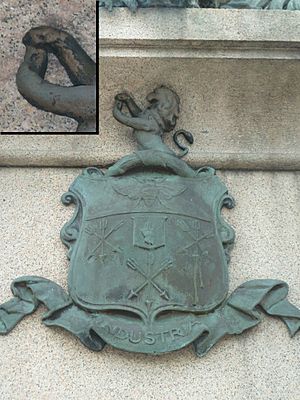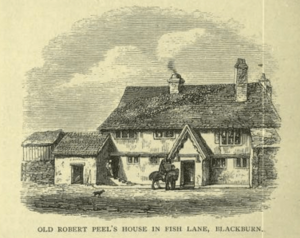Parsley Peel facts for kids
Quick facts for kids
Robert Peel
|
|
|---|---|

The Peel arms commissioned by Parsley Peel. Inset to show the lion is holding a shuttle.
|
|
| Born |
Robert Peele
1723 Peele Fold, Oswaldtwistle, England
|
| Died | September 1795 (aged 71–72) |
| Other names | "Parsley" Peel |
| Known for | Textile manufacturer |
| Spouse(s) | Elizabeth Haworth |
| Children | William, Edmund Sir Robert Peel, 1st Baronet Laurence, Joseph John, Anne |
| Parent(s) | William Peele Jane Anne Peele |
Robert Peel (1723 – 12 September 1795), often called Parsley Peel, was a very important owner of cotton mills. He was the grandfather of Sir Robert Peel, 2nd Baronet, who later became the Prime Minister of the United Kingdom. Robert Peel started his life as a farmer. However, he began to experiment with printing patterns on fabric. He even created a special parsley leaf design that became famous for his company. Even though he lost some machines in riots, his company grew to be the biggest in the textile industry by the time he died. He owned 23 factories!
Contents
Robert Peel's Early Life
Robert Peele was born in 1723 in a place called Peele Fold in Oswaldtwistle, England. His parents were William Peele and Jane Anne Walmsley. His family had traditionally been yeoman farmers. This means they owned and farmed their own land. However, his grandfather, also named Robert Peele, stopped farming to make woollen cloth.
Starting a New Business
Parsley's father, William, tried to go back to farming. After Robert finished school at Blackburn Grammar School, he first helped his father on the farm. He inherited the wooden blocks his grandfather used for printing on wool. Robert started trying out new designs with these blocks.
His wife's brother, Jonathan Haworth, had learned about calico printing in London. Calico printing is a way to print colourful patterns on cotton fabric. In 1750, Robert and Jonathan decided to start a business together. They got money from William Yates, who owned a local pub. They formed a company called Haworth, Peel and Yates. They had a factory in Blackburn and a warehouse in Manchester. Around this time, Robert dropped the last 'e' from his last name. He said it "was of no use" because it didn't change how his name sounded.
The Famous Parsley Pattern
Robert Peel was known for trying new ideas in the textile industry. He was one of the first to use new machines called carding cylinders. These machines helped prepare cotton for spinning. He started experimenting with different ways of printing at his home.
How the Parsley Pattern Was Born
Family stories say that one day, his young daughter Anne brought him a sprig of parsley. She asked him to use it as a pattern. Robert then carved this parsley design onto a pewter plate. This plate was used to print the pattern. After printing, a woman in the house would use an iron to finish the fabric.
There are other versions of this story. Some say the experiments happened at his farm, Peel Fold. Others say it was at his house in Fish Lane. Another story suggests a poor neighbour, Mrs. Milton, helped by pressing the cloth to make it smooth and shiny.
The Secret of the Design
Exactly what Robert Peel discovered is not completely clear. It might have been a new way to use a special chemical called acetate of lead. This chemical helps the dye stick to the fabric. It's called a mordant. Another idea is that he used metal engraving instead of wooden blocks for the pattern.
However it happened, the pattern was named "Nancy's pattern" after his daughter. It became very popular! This popular design led to Robert Peel's nickname, "Parsley Peel." His company became one of the first to print calico in Lancashire.
Growing the Cotton Business
Robert Peel worked with one of his weavers, James Hargreaves. They looked into new technologies together. In 1762, Peel and Hargreaves set up a carding machine. But they decided not to use it yet.
Facing Challenges and Riots
In 1764, James Hargreaves invented the spinning jenny. This machine could spin many threads at once, much faster than by hand. Robert Peel was very eager to use this new technology. He put spinning jennies in his factory at Stanhill, where Hargreaves worked.
In the spring of 1768, people blamed the spinning jennies at Peel's factory for job losses. Workers feared the machines would take their jobs. A riot broke out, and people attacked the factories and Hargreaves' nearby house. They destroyed the spinning jennies and some of Peel's own inventions. Because of this, Peel moved his manufacturing out of Lancashire. He chose Burton-upon-Trent and built three mills there. He even dug a canal for one of them.
In 1779, Peel's mill in Altham was also attacked during riots against machinery. These riots targeted carding machines and spinning jennies. Peel saw this destruction as a chance to improve. He then started using Richard Arkwright's improved carding "engine." By 1795, Peel's family company, Peel & Co., was the biggest in the cotton industry. They had twenty-three mills across the north west of England. This was fourteen more than their closest competitor!
Robert Peel's Family Life
People described Robert Peel as "a tall robust man" with reddish hair. He was careful but also very smart. He helped his family become wealthy through hard work and determination. He married Elizabeth Haworth on 28 August 1744. They had eight children. One of their children was Sir Robert Peel, 1st Baronet.
A Family Legacy
Sir Robert Peel, 1st Baronet, later became the father of Sir Robert Peel, 2nd Baronet. This younger Robert Peel became the Prime Minister of the United Kingdom. He is famous for helping to create the modern police force. Young Robert would often visit Parsley Peel and his wife at their home in Ardwick.
Douglas Hurd, a writer, noted that Parsley Peel was happy with his own achievements. He didn't expect to become famous himself. However, he hoped his children would rise higher in society.
His Later Years
A religious leader named John Wesley once said about him, "I was invited to breakfast at Bury by Mr Peel, a calico printer who a few years ago began with £500 and is now supposed to have gained £20,000." This shows how successful he became.
In 1794, Parsley Peel received a special grant for a coat of arms. This family symbol included a shuttle (a tool used in weaving) held by a lion. It also had a bee, which meant business. His new family motto was Industria, which means "Industry" or "Hard Work."
Towards the end of his life, Peel leaned heavily on a cane with a golden head. He spent his last days in Ardwick Green, close to his daughter. Robert Peel died on 12 September 1795. He was buried in St John's Church, Manchester. His wife lived for six more months. One of her last wishes was to live longer than her husband. He left his wealth equally to his eight children. Each child received about £13,000, which would be worth about £1.1 million today.
Images for kids



